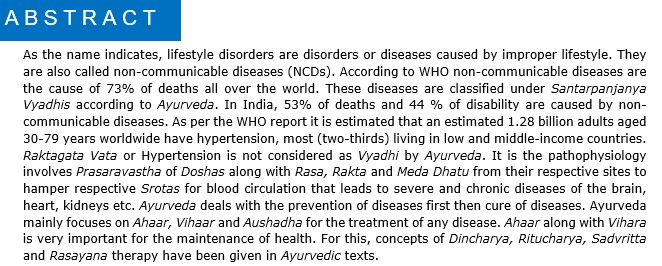Lifestyle Disorders and Ayurveda with special reference to Raktagata Vata (Hypertension)
DOI:
https://doi.org/10.21760/jaims.9.1.22Keywords:
Non-communicable diseases, Hypertension, Santarpanjanya Vyadhi, Dincharya, Ritucahrya, Sadvritta, Rasayana therapyAbstract
As the name indicates, lifestyle disorders are disorders or diseases caused by improper lifestyle. They are also called non-communicable diseases (NCDs). According to WHO non-communicable diseases are the cause of 73% of deaths all over the world. These diseases are classified under Santarpanjanya Vyadhis according to Ayurveda. In India, 53% of deaths and 44 % of disability are caused by non-communicable diseases. As per the WHO report it is estimated that an estimated 1.28 billion adults aged 30-79 years worldwide have hypertension, most (two-thirds) living in low and middle-income countries. Raktagata Vata or Hypertension is not considered as Vyadhi by Ayurveda. It is the pathophysiology involves Prasaravastha of Doshas along with Rasa, Rakta and Meda Dhatu from their respective sites to hamper respective Srotas for blood circulation that leads to severe and chronic diseases of the brain, heart, kidneys etc. Ayurveda deals with the prevention of diseases first then cure of diseases. Ayurveda mainly focuses on Ahaar, Vihaar and Aushadha for the treatment of any disease. Ahaar along with Vihara is very important for the maintenance of health. For this, concepts of Dincharya, Ritucharya, Sadvritta and Rasayana therapy have been given in Ayurvedic texts.
Downloads
References
WHO. Report of Prevention and Control for Cardiovascular Diseases, 2001-2002 [Internet]. Available from: http://www.sld.cu/./pdf/./international cardiovascular disease statistics [Accessed on: Date].
Moser M, Roccella EJ. The treatment of hypertension: a remarkable success story. J Clin Hypertens (Greenwich). 2013;15:88-91.
Whelton PK. Global burden of hypertension: an analysis of worldwide data. Lancet. 2005;365(9455):217-223.
Pierdomenico SD, et al. Prognostic value of different indices of blood pressure variability in hypertensive patients. Am J Hypertens. 2009;22(8):842-847.
Shah SN. API Textbook of Medicine. 7th ed. 2003:457-459, 430-432.
Fagher B, Valind D, Thulin T. End organ damage in treated severe hypertension: Close relation to nocturnal blood pressure. J Hum Hypertens. 1995;9(8):605-610.
Tierney LM Jr, McPhee SJ, Papadakis MA. Current Medical Diagnosis and Treatment. 41st ed. Lange Medical Books; 2002:462-463.
Charaka Samhita. Yadavaji Trikamji, editor. Reprint edition. Chaukhamba Sanskrit Sansthana, Varanasi; 2009. Sutrasthana, 18/46:108.
Taber's Cyclopedic Medical Dictionary. 20th ed. 2005:268, 1039.
Taber's Cyclopedic Medical Dictionary. 20th ed. 2005:268, 1039.
Shah SN. API Textbook of Medicine. 7th ed. 2003.
Charaka Samhita. Vaidya Yadavaji Trikamaji Acharya, editor. Chaukhmba surbharati prakashana, reprint 2000. Ch. Su.12.
Charaka Samhita. Vaidya Yadavaji Trikamaji Acharya, editor. Chaukhmba surbharati prakashana, reprint 2000. Ch. Su.18/49.
Charaka Samhita. Vaidya Yadavaji Trikamaji Acharya, editor. Chaukhmba surbharati prakashana, reprint 2000. Ch. Su.18/44-46.
Sanapeti R. Clinical Study on the effect of Takradhara in the Essential Hypertension.
Vagbhata V. Ashtanga Samgraha. Shivaprasad Sharma, editor. 2nd ed. Chaukhamba Sanskrit series office, Varanasi; 2008. Sutrasthana 20/6:156.
Vagbhata V. Ashtanga Samgraha. Shivaprasad Sharma, editor. 2nd ed. Chaukhamba Sanskrit series office, Varanasi; 2008. Sutrasthana 20/6:156.
Sharangadhara. Sharangadhara Samhita. Shailaja Shrivastava, editor. Reprint edition. Chaukhamba Orientalia, Varanasi; 2009. Poorvakhanda 6/8, 52.
Tirtha SS. The Ayurveda Encyclopedia. RC Uniyal, editor. 5th ed. Ayurveda holistic center press, USA; 2005:360.
Desai R. Ayurvediya Kriyasharira. 5th ed. Baidyanath Ayurveda Bhawan Ltd., Allahabad; 2003:741.
Sharma RK, et al. Caraka Samhita Volume 2. Chaukhamba Sanskrit Series Office, Varanasi; 1994. Ch. Vi. 5/12-14:178-179.
Sharma RK, et al. Caraka Samhita Volume 1. Chaukhamba Sanskrit Series Office, Varanasi; 1995. Ch. Su.20/17:370.
Patel D, et al. Role of Manas Bhavas in the etiopathogenesis of Uccharaktachapa (EHT) and its management with Medhya Rasayana and ShiVithalani Lalitkumar V. Et; Al: Hypertension - An Ayurvedic Perspective.
IAMJ: Volume 3; Issue 11; November- 2015 rodhara, MD thesis, GAU, Jamnagar,2003. Available from: [URL].
Upadhayaya VY, editor. Ashtanghridyam Sootrsthana ch.13/25. 8th ed. Chaukhamba Prakashan, Varanasi; 111.
Appel LJ, et al. A clinical trial of the effects of dietary patterns on blood pressure. N Engl J Med. 1997;336(16):1117-1124.
Tripathi B. Charak Samhita Vol.1. Chaukhambha Surbharati Prakashan, Varanasi; 2009. Vimanasthana 1/15;660.
Padwal RJ, et al. The 2010 Canadian Hypertension Education Program recommendations for the management of hypertension: Part 2 – Therapy. Can J Cardiol. 2010;26(5):249-258.
Rainforth MV, et al. Stress Reduction Programs in Patients with Elevated Blood Pressure: A Systematic Review and Meta-analysis. Curr Hypertens Rep. 2007;9(6):520-528.
http://nopr.niscair.res.in/bitstream/123 456789/8524 /1/IJTK%204(4)%20367-372.pdf)
http://shodhganga.inflibnet.ac.in/bitstream/10603/ 34853/8/08_literary%20 review.pdf
Susruta. Susrutasamhita. Vaidya Yadavaji Trikamaji Acharya, editor. 7th edition. Chaukhamba Surabharathi Prakashan, Varanasi; 2008. Sharirsthana 4/3 32.
Tortora G, Derrickson B. Principles of Anatomy and Physiology13th edition. Wiley; 2012:815.














